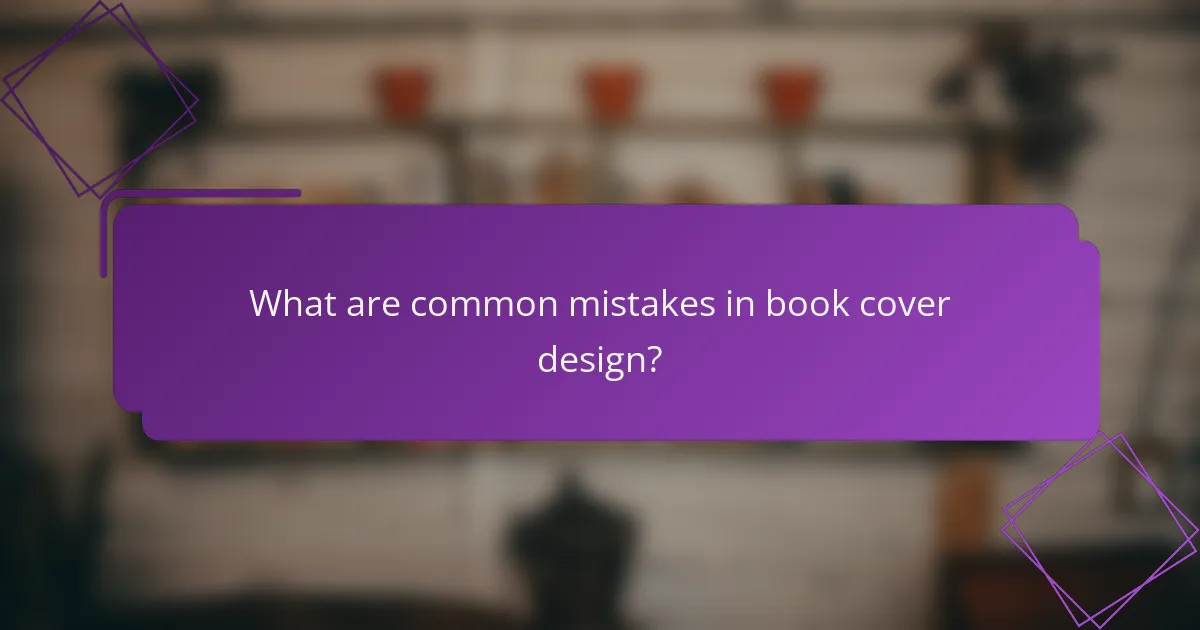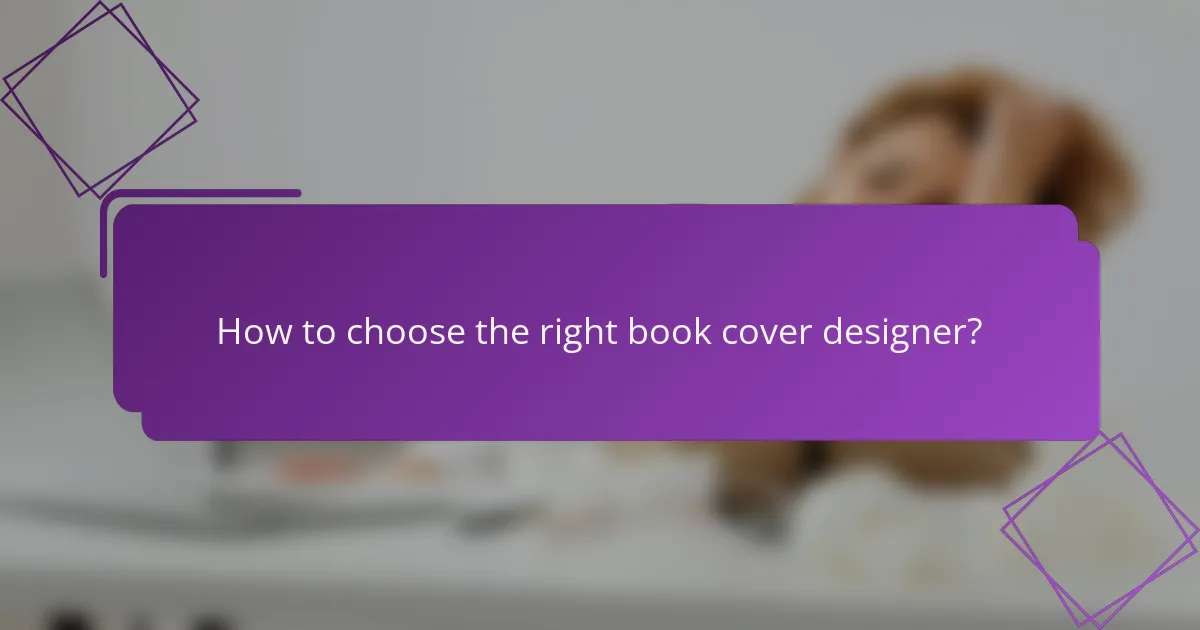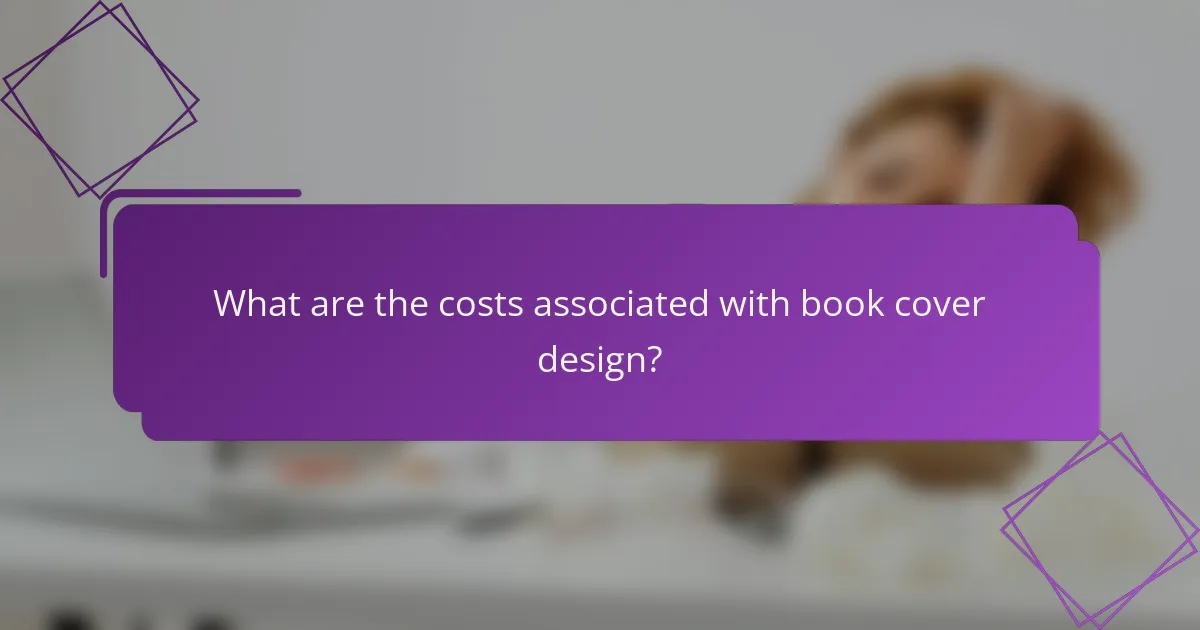Book cover design is a crucial aspect of publishing that begins with developing a concept tailored to the target audience and genre. This process involves strategic execution, including the careful selection of typography, color palettes, and imagery to create an appealing visual representation. Finally, the design is refined through feedback and revisions, ensuring it effectively captures the book’s essence and attracts potential readers.

How to develop a book cover design concept?
Developing a book cover design concept involves understanding the target audience, analyzing genre trends, and defining key themes. This foundational work sets the stage for creating a visually appealing and marketable cover that resonates with readers.
Research target audience
Understanding your target audience is crucial for effective book cover design. Consider factors such as age, gender, interests, and reading habits to tailor the design to their preferences. For example, a cover for a young adult fantasy novel may feature vibrant colors and whimsical elements, while a cover for a historical nonfiction book might adopt a more subdued, classic style.
Engaging with potential readers through surveys or social media can provide valuable insights into what appeals to them visually. This research helps ensure that the cover design aligns with the expectations of the intended readership.
Analyze genre trends
Each book genre has distinct visual trends that can influence cover design. Familiarize yourself with current popular styles within your genre by examining bestsellers and award-winning titles. For instance, thriller novels often use dark colors and bold typography, while romance covers might feature soft pastels and romantic imagery.
Staying updated on genre trends can help your book stand out while still fitting within the expectations of the market. Utilize resources like Goodreads or genre-specific blogs to identify these trends effectively.
Create mood boards
Mood boards are a powerful tool for visualizing the overall aesthetic of your book cover. Compile images, color palettes, typography examples, and textures that evoke the themes and emotions of your book. This can include inspiration from other book covers, art, or photography.
Creating a mood board helps clarify your vision and serves as a reference point throughout the design process. Tools like Pinterest or Adobe Spark can facilitate the creation of digital mood boards that are easy to share with collaborators.
Define key themes
Identifying the key themes of your book is essential for effective cover design. Consider the main ideas, emotions, and messages you want to convey. For example, if your book explores themes of resilience and hope, your cover might incorporate uplifting imagery and bright colors.
Write down a few keywords that encapsulate your book’s essence, as these will guide your design choices and ensure that the final cover accurately reflects the story within.
Sketch initial ideas
Once you have a clear understanding of your audience, genre trends, mood, and themes, begin sketching initial cover ideas. These sketches don’t need to be polished; they should capture your concepts and layout ideas. Experiment with different compositions, typography placements, and imagery.
Share your sketches with trusted peers or potential readers for feedback. This iterative process can help refine your ideas and lead to a more effective final design that resonates with your audience.

What are the best practices for book cover design execution?
Effective book cover design execution involves a blend of creativity and strategic choices that resonate with the target audience. Key practices include selecting the right typography, color palettes, and imagery, along with utilizing professional design software to bring the vision to life.
Choose appropriate typography
Typography plays a crucial role in conveying the book’s genre and tone. Choose fonts that reflect the content; for instance, serif fonts often suggest tradition and reliability, while sans-serif fonts can imply modernity and simplicity. Aim for a maximum of two to three font styles to maintain visual coherence.
Consider readability, especially at smaller sizes. Titles should be legible from a distance, so avoid overly ornate fonts. A good rule of thumb is to ensure that the title is at least 36 points in size for print covers.
Select color palettes
The color palette of a book cover can evoke emotions and attract readers. Select colors that align with the book’s themes; for example, dark hues may suggest mystery, while bright colors can indicate a lighthearted story. Limit the palette to three to five colors to avoid overwhelming the viewer.
Utilize color theory to create contrast and harmony. Tools like Adobe Color can help in selecting complementary colors. Always consider how colors will appear in both print and digital formats, as they can differ significantly.
Incorporate imagery effectively
Imagery should enhance the book’s message and attract potential readers. Use high-quality images that are relevant to the content, whether they are illustrations, photographs, or graphics. Ensure that the imagery is not cluttered and allows the title and author name to stand out.
Consider the placement of images in relation to text. A common approach is to position the image as a background or to the side, ensuring it does not distract from the title. Always check that images are licensed for use, especially for commercial projects.
Utilize design software like Adobe InDesign
Professional design software such as Adobe InDesign is essential for creating polished book covers. It allows for precise control over layout, typography, and image placement. Familiarize yourself with its features, such as master pages and styles, to streamline the design process.
For those on a budget, alternatives like Canva or GIMP can also be effective, though they may offer less flexibility. Regardless of the software, ensure that the final design meets the required specifications for print or digital publishing, including resolution and bleed settings.

How to finalize a book cover design?
Finalizing a book cover design involves gathering feedback, making revisions, and preparing files for printing. This process ensures that the cover effectively communicates the book’s theme and appeals to the target audience.
Gather feedback from focus groups
Collecting feedback from focus groups is crucial for understanding how your book cover resonates with potential readers. Assemble a diverse group that reflects your target audience and present them with your design options.
Encourage participants to share their thoughts on elements like color, imagery, and typography. Consider using surveys or structured discussions to capture their insights effectively.
Make necessary revisions
After gathering feedback, identify common themes and suggestions for improvement. Prioritize revisions that enhance clarity and appeal, while staying true to your original vision.
Be open to making significant changes if feedback indicates that the design is not connecting with readers. This may involve altering colors, fonts, or even the overall layout to better align with audience expectations.
Prepare print-ready files
Once revisions are complete, ensure that your book cover files are print-ready. This typically involves setting the correct dimensions, resolution (at least 300 DPI), and color mode (CMYK for print).
Double-check that all text is embedded and images are high quality. Save your final design in the appropriate formats, such as PDF or TIFF, as required by your printer to avoid any issues during production.

What are common mistakes in book cover design?
Common mistakes in book cover design include failing to adhere to genre conventions and overcomplicating design elements. These errors can lead to a cover that confuses potential readers or fails to attract the right audience.
Ignoring genre conventions
Each genre has specific visual cues that readers expect on book covers. For instance, romance novels often feature soft colors and romantic imagery, while thrillers may use darker tones and bold typography. Ignoring these conventions can result in a cover that misrepresents the book’s content.
To avoid this mistake, research successful covers within your genre. Analyze common themes, colors, and fonts, and consider how your design can align with these elements while still being unique. This approach helps ensure your cover resonates with its intended audience.
Overcomplicating design elements
Overly complex designs can overwhelm potential readers and obscure the book’s message. A cluttered cover with too many images, fonts, or colors can detract from the title and author name, making it difficult for viewers to engage. Simplicity often leads to a more effective design.
Focus on a clean layout that highlights key elements. Use one or two main images and limit your color palette to a few complementary shades. This strategy not only enhances readability but also creates a more professional appearance that can attract buyers.

How to choose the right book cover designer?
Choosing the right book cover designer is crucial for creating an appealing and marketable book. Look for a designer whose style aligns with your vision and who understands your target audience.
Review portfolios
Start by examining the portfolios of potential designers. A strong portfolio should showcase a variety of styles and genres, demonstrating their versatility and creativity. Look for covers that resonate with you and reflect the quality you desire for your book.
Pay attention to the details in their designs, such as typography, color schemes, and imagery. A cohesive and professional look is essential, as it indicates the designer’s skill and attention to detail.
Check client testimonials
Client testimonials provide insight into a designer’s reliability and professionalism. Look for reviews that highlight the designer’s communication skills, adherence to deadlines, and ability to incorporate feedback. Positive experiences from previous clients can indicate a trustworthy partnership.
Consider reaching out to past clients for direct feedback. This can give you a clearer picture of what to expect in terms of collaboration and the overall design process.
Discuss design process
Understanding a designer’s process is key to ensuring a smooth collaboration. Discuss how they approach concept development, revisions, and finalization. A good designer will have a structured process that includes initial brainstorming, drafts, and opportunities for your input.
Clarify timelines and deliverables upfront. Knowing how long each phase will take helps manage expectations and ensures you stay on track for your book’s release. Aim for a designer who is flexible and open to your ideas while also providing professional guidance.

What are the costs associated with book cover design?
The costs of book cover design can vary widely based on factors such as the designer’s experience, the complexity of the design, and the market. Generally, you can expect to pay anywhere from a few hundred to several thousand dollars for a professional cover design.
Freelance Designer Costs
Hiring a freelance designer typically ranges from about $300 to $2,000. Newer designers may charge less, while established professionals with a strong portfolio will command higher fees. It’s important to review their previous work to ensure their style aligns with your vision.
Design Agency Costs
Design agencies often charge more due to their comprehensive services, which can include market research and multiple design concepts. Costs can range from $1,000 to $5,000 or more, depending on the agency’s reputation and the project’s scope.
DIY Design Costs
If you choose to design your cover yourself, costs can be significantly lower, primarily involving software subscriptions or one-time purchases. Tools like Adobe InDesign or Canva can be used, with costs ranging from free to around $50 per month for premium features.
Additional Costs
Consider additional expenses such as stock images, typography licenses, and printing costs. Stock images can range from $10 to $100 each, while custom illustrations may cost significantly more. Always factor these into your overall budget for a complete picture of your design expenses.


